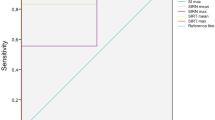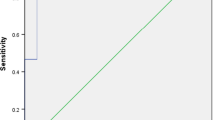Abstract
Purpose
To explore the value of morphology and diffusion features on CT and MRI in the characterization of external auditory canal and middle ear tumors (EAMETs).
Methods
Forty-seven patients with histologically proved EAMETs (23 benign and 24 malignant) who underwent CT and MRI were retrospectively analyzed in this study. CT and MRI characteristics (including size, shape, signal intensity, border, enhancement degree, and bone changes) and apparent diffusion coefficient (ADC) value were analyzed and compared between benign and malignant EAMETs. Logistic regression, receiver operating characteristic (ROC) curve, and Delong test were performed to assess the diagnostic performance.
Results
Compared with benign tumors, the malignant EAMETs are characterized by irregular shape, ill-defined border, invasive bone destruction, and intense enhancement (all p < 0.05). There were no significant differences on the size and signal intensity between benign and malignant tumors. The ADC value of malignant tumors were (879.96 ± 201.15) × 10–6 mm2/s, which was significantly lower than benign ones (p < 0.05). Logistic regression demonstrates the presence of ill-defined margin, invasive bone destruction, and low ADC value (≤ 920.33 × 10–6 mm2/s) have significant relationship with malignant EAMETs. The combination of characterization by morphology and diffusion features on CT and MRI can further improve the diagnostic efficiency when compared with morphology and diffusion features alone (both p < 0.05).
Conclusion
Some CT and MRI characteristics are helpful in identifying malignant EAMETs from benign ones (especially ill-defined margin, invasive bone destruction, and low ADC value), and the combination of morphology and diffusion features on CT and MRI has best diagnostic efficiency for discriminating these two entities.



Similar content being viewed by others
References
Juliano AF, Ginat DT, Moonis G (2013) Imaging review of the temporal bone: part I. Anatomy and inflammatory and neoplastic processes. Radiology 269(1):17–33. https://doi.org/10.1148/radiol.13120733
Lionello M, Stritoni P, Facciolo MC et al (2014) Temporal bone carcinoma. Current diagnostic, therapeutic, and prognostic concepts. J Surg Oncol 110(4):383–392. https://doi.org/10.1002/jso.23660
Da Silva AP, Breda E, Monteiro E (2016) Malignant tumors of the temporal bone—our experience. Braz J Otorhinolar 82(4):479–483. https://doi.org/10.1016/j.bjorl.2015.09.010
Prasad SC, D’Orazio F, Medina M et al (2014) State of the art in temporal bone malignancies. Curr Opin Otolaryngol 22(2):154–165. https://doi.org/10.1097/MOO.0000000000000035
McClellan JH, Ewing E, Gupta S (2018) Squamous papilloma of the external auditory canal. Otol Neurotol 39(5):e413–e415. https://doi.org/10.1097/MAO.0000000000001783
Colas L, Caron S, Cotten A (2015) Skull vault lesions: a review. AJR Am J Roentgenol 205(4):840–847. https://doi.org/10.2214/AJR.14.13415
Tu Z, Xiao Z, Zheng Y et al (2019) Benign and malignant skull-involved lesions: discriminative value of conventional CT and MRI combined with diffusion-weighted MRI. Acta Radiol 60(7):880–886. https://doi.org/10.1177/0284185118773541
Wang J, Takashima S, Takayama F et al (2001) Head and neck lesions: characterization with diffusion-weighted echo-planar MR imaging. Radiology 220(3):621–630. https://doi.org/10.1148/radiol.2202010063
Serifoglu I, Oz II, Damar M et al (2015) Diffusion-weighted imaging in the head and neck region: usefulness of apparent diffusion coefficient values for characterization of lesions. Diagn Interv Radiol 21(3):208–214. https://doi.org/10.5152/dir.2014.14279
Bhatt N, Gupta N, Soni N et al (2017) Role of diffusion-weighted imaging in head and neck lesions: Pictorial review. Neuroradiol J 30(4):356–369. https://doi.org/10.1177/1971400917708582
Koyasu S, Iima M, Umeoka S et al (2014) The clinical utility of reduced-distortion readout-segmented echo-planar imaging in the head and neck region: initial experience. Eur Radiol 24(12):3088–3096. https://doi.org/10.1007/s00330-014-3369-5
Holdsworth SJ, Skare S, Newbould RD et al (2008) Readout-segmented EPI for rapid high resolution diffusion imaging at 3 T. Eur J Radiol 65(1):36–46. https://doi.org/10.1016/j.ejrad.2007.09.016
DeLong ER, DeLong DM, Clarke-Pearson DL (1988) Comparing the areas under two or more correlated receiver operating characteristic curves: a nonparametric approach. Biometrics 44(3):837–845
Landis JR, Koch GG (1977) The measurement of observer agreement for categorical data. Biometrics 33(1):159–174
Koo TK, Li MY (2016) A guideline of selecting and reporting intraclass correlation coefficients for reliability research. J Chirop Med 15(2):155–163
Bird CR, Hasso AN, Stewart CE et al (1983) Malignant primary neoplasms of the ear and temporal bone studied by high-resolution computed tomography. Radiology 149(1):171–174. https://doi.org/10.1148/radiology.149.1.6310679
Wiggins RR, Harnsberger HR, Salzman KL et al (2006) The many faces of facial nerve schwannoma. AJNR Am J Neuroradiol 27(3):694–699
Garfinkle J, Melancon D, Cortes M et al (2011) Imaging pattern of calvarial lesions in adults. Skeletal Radiol 40(10):1261–1273. https://doi.org/10.1007/s00256-010-0971-8
Yuan Y, Tang W, Tao X (2016) Parotid gland lesions: separate and combined diagnostic value of conventional MRI, diffusion-weighted imaging and dynamic contrast-enhanced MRI. Br J Radiol 89(1060):20150912. https://doi.org/10.1259/bjr.20150912
Marioni G, Nucci R, Marino F et al (2012) Neoangiogenesis in temporal bone carcinoma: the prognostic role of CD105. Otol Neurotol 33(5):843–848. https://doi.org/10.1097/MAO.0b013e318254edc9
Caldemeyer KS, Mathews VP, Azzarelli B et al (1997) The jugular foramen: a review of anatomy, masses, and imaging characteristics. Radiographics 17(5):1123–1139. https://doi.org/10.1148/radiographics.17.5.9308106
Rao AB, Koeller KK, Adair CF (1999) From the archives of the AFIP. Paragangliomas of the head and neck: radiologic-pathologic correlation. Armed Forces Institute of Pathology. Radiographics 19(6):1605–1632. https://doi.org/10.1148/radiographics.19.6.g99no251605
De Foer B, Kenis C, Vercruysse J et al (2009) Imaging of temporal bone tumors. Neuroimag Clin N Am 19(3):339–366. https://doi.org/10.1016/j.nic.2009.06.003
Mundada P, Purohit BS, Kumar TS et al (2016) Imaging of facial nerve schwannomas: diagnostic pearls and potential pitfalls. Diagn Interv Radiol 22(1):40–46. https://doi.org/10.5152/dir.2015.15060
Le Bihan D (1995) Molecular diffusion, tissue microdynamics and microstructure. NMR Biomed 8(7–8):375–386. https://doi.org/10.1002/nbm.1940080711
De Foer B, Vercruysse J, Spaepen M et al (2010) Diffusion-weighted magnetic resonance imaging of the temporal bone. Neuroradiology 52(9):785–807. https://doi.org/10.1007/s00234-010-0742-1
De Foer B, Vercruysse JP, Pilet B et al (2006) Single-shot, turbo spin-echo, diffusion-weighted imaging versus spin-echo-planar, diffusion-weighted imaging in the detection of acquired middle ear cholesteatoma. AJNR Am J Neuroradiol 27(7):1480–1482
Zhao M, Liu Z, Sha Y et al (2016) Readout-segmented echo-planar imaging in the evaluation of sinonasal lesions: a comprehensive comparison of image quality in single-shot echo-planar imaging. Magn Reson Imaging 34(2):166–172. https://doi.org/10.1016/j.mri.2015.10.010
Yu JY, Zhang D, Huang XL et al (2020) Quantitative Analysis of DCE-MRI and RESOLVE-DWI for differentiating nasopharyngeal carcinoma from nasopharyngeal lymphoid hyperplasia. J Med Syst 44(4):75. https://doi.org/10.1007/s10916-020-01549-y
Mathur A, Jain N, Kesavadas C et al (2015) Imaging of skull base pathologies: role of advanced magnetic resonance imaging techniques. Neuroradiol J 28(4):426–437. https://doi.org/10.1177/1971400915609341
Lee JH, Seo JH, Park KH et al (2012) A case of malignant small round cell tumor of temporal bone with facial paralysis. Korean J Audiol 16(3):145–147. https://doi.org/10.7874/kja.2012.16.3.145
Funding
This study was supported by a grant-in-aid for scientific research from the Technology Plan of Jiangsu (No. H2019087), Translational Medicine Project of Wuxi health commission (No. ZZ002), and Youth Project of Wuxi health commission (No. Q202112).
Author information
Authors and Affiliations
Corresponding authors
Ethics declarations
Conflict of interest
None.
Additional information
Publisher's Note
Springer Nature remains neutral with regard to jurisdictional claims in published maps and institutional affiliations.
Rights and permissions
About this article
Cite this article
Wang, P., Zhang, H., Zhao, J. et al. External auditory canal and middle ear tumors: characterization by morphology and diffusion features on CT and MRI. Eur Arch Otorhinolaryngol 280, 605–611 (2023). https://doi.org/10.1007/s00405-022-07509-1
Received:
Accepted:
Published:
Issue Date:
DOI: https://doi.org/10.1007/s00405-022-07509-1




